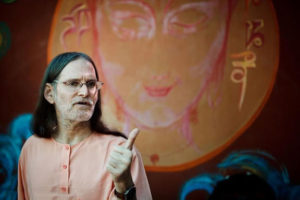 This series continues with part 3, in which we’re going to start at the very beginning. I remember, growing up, Julie Andrews singing in the film The Sound of Music, “A very good place to start . . .” So we’ll start with chapter 1, verse 1 of the Bhagavad Gita. Take a slow, deep breath. Feel your body relaxing, the mind quieting down. Your heart is open. Your spirit’s receptive.
This series continues with part 3, in which we’re going to start at the very beginning. I remember, growing up, Julie Andrews singing in the film The Sound of Music, “A very good place to start . . .” So we’ll start with chapter 1, verse 1 of the Bhagavad Gita. Take a slow, deep breath. Feel your body relaxing, the mind quieting down. Your heart is open. Your spirit’s receptive.
I’ll read you the first verse of the first chapter:
Dhritarāśhtra asked, What did the Pāndavās and my sons do when they assembled on the holy land of Kurukshetra, eager to fight, O Sanjaya?
So let’s talk about who Dhritarāśhtra is. He’s a king. He’s the ruler of the country. He’s also blind, a metaphor in the Gita for spiritual blindness. You can be a good king when you’re a blind man, but his blindness isn’t limited to his physical eyes. His eyes, which represent individual consciousness, also can’t see or at least can’t see straight. So in this country, we have a blind ruler, unfortunately. Blindness represents the fact that even though we’ve read so much and know so much we still tend to look outside for our fulfillment, even though we know that’s not going to happen.
Our tamas (inertia) also blinds us by covering over the inner light. Our rajas (restlessness) pushes us outward and makes us focus outside of ourselves. And we also are blind to how our conditioning is functioning—our samskaras are mostly operating under the surface. They cause us to see things in a filtered and distorted way and then we react to what we see in a preprogrammed way, with deeply ingrained patterns. And this kind of seeing is actually worse than blindness. A blind person at least knows they can’t see, but we think that we’re seeing reality when it’s just not so.
So I gave myself a homework assignment for the week that I’ll share with you and encourage you to take on as well. This week I’m going to focus on the fact that my point of view may not be truly objective. I’m going to listen more deeply to different points of view and watch my reactions when people see things differently from the way I do.
About the Author:
 Swami Asokananda, initiated into monkhood in 1973 by Sri Swami Satchidananda, is the spiritual director of Integral Yoga Institute of New York, co-director of the Integral Yoga Global Network, and one of Integral Yoga’s foremost teachers. He is the primary instructor for the Intermediate and Advanced Hatha Yoga Teacher Trainings offered around the world. He has deeply studied the Bhagavad Gita for many decades and is currently writing a commentary.
Swami Asokananda, initiated into monkhood in 1973 by Sri Swami Satchidananda, is the spiritual director of Integral Yoga Institute of New York, co-director of the Integral Yoga Global Network, and one of Integral Yoga’s foremost teachers. He is the primary instructor for the Intermediate and Advanced Hatha Yoga Teacher Trainings offered around the world. He has deeply studied the Bhagavad Gita for many decades and is currently writing a commentary.

